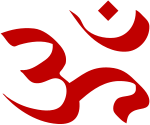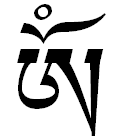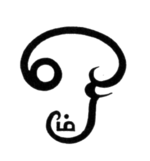Aum
From Wikipedia, the free encyclopedia


Aum (also Om, written in Devanagari as ॐ, in Chinese as 唵, in Tibetan as ༀ, in Sanskrit known as praṇava or omkāra) is a mystical or sacred syllable in the Indian religions, including Hinduism, Jainism, and Buddhism. The omkara is taken as a name of God in Arya Samaj.
It is pronounced as a long or over-long nasalized close-mid back rounded vowel (IPA [oːⁿ]).
It is placed at the beginning of most Hindu texts as a sacred exclamation to be uttered at the beginning and end of a reading of the Vedas or previously to any prayer or mantra. The Mandukya Upanishad is entirely devoted to the explanation of the syllable.
Contents |
[edit] Name, phonology and written representation
The Sanskrit name for the syllable is praṇava, from a root nu "to shout, sound, praise", verbal pra-nu- being attested as "to make a humming or droning sound" in the Brahmanas, and taking the specific meaning of "to utter the syllable om" in the Chandogya Upanishad and the Shrauta Sutras. More rarely used terms are akṣara or ekākṣara, and in later times omkāra becomes prevalent.
Phonematically, the syllable is /aum/, which is regularly monophtongized to [oːⁿ] (i.e., a nasalized long close-mid back rounded vowel) in Sanskrit phonology. It is sometimes also written with pluti, as /o3m/ (ओ३म्), notably by Arya Samaj. When occurring within a Sanskrit utterance, the syllable is subject to the normal rules of sandhi in Sanskrit grammar, however with the additional peculiarity that after preceding a or ā, the o of om does not form vriddhi (au) but guna (o) per Pāṇini 6.1.95.
The Aum symbol ![]() is a ligature of Devanagari ओ+ँ (oṃ, encoded in Unicode at U+0950 ॐ, the Tibetan script variant ༀ at U+0F00, and the Chinese 唵 at U+5535 or 吽 at U+543D).
is a ligature of Devanagari ओ+ँ (oṃ, encoded in Unicode at U+0950 ॐ, the Tibetan script variant ༀ at U+0F00, and the Chinese 唵 at U+5535 or 吽 at U+543D).
[edit] In Hinduism
The syllable Aum is first described as all-encompassing mystical entity in the Upanishads. Today, in all Hindu art and all over India and Nepal, 'Aum' can be seen virtually everywhere, a common sign for Hinduism and its philosophy and theology.
[edit] Upanishads and Sutra literature
The syllable is mentioned in all the Upanishads, specially elaborated upon in the Taittiriya, Chandogya and Mandukya Upanishad set forth as the object of profound religious meditation, the highest spiritual efficacy being attributed not only to the whole word but also to the three sounds a (a-kāra), u (u-kāra), m (ma-kāra), of which it consists. A-kara means form or shape like earth, trees, or any other object. U-kara means formless or shapeless like water, air or fire. Ma-kara means neither shape nor shapeless (but still exists) like the dark matter in the Universe. When we combine all three syllables we get AUM which is a combination of A-kara,U-kara, andMa-kara.[1]
The Katha Upanishad has:
- "The goal, which all Vedas declare, which all austerities aim at, and which humans desire when they live a life of continence, I will tell you briefly it is Aum"
- "The one syllable [evākṣara, viz. Aum] is indeed Brahman. This one syllable is the highest. Whosoever knows this one syllable obtains all that he desires.
- "This is the best support; this is the highest support. Whosoever knows this support is adored in the world of Brahma." (1.2.15-17)[2]
The Chandogya Upanishad (1.1.1-1) states:
- om ity etad akṣaram udgītham upāsīta / om iti hy udgāyati / tasyopavyākhyānam
- "The udgitha ["the chanting", that is, the syllable om] is the best of all essences, the highest, deserving the highest place, the eighth."
The Bhagavad Gita (8.13) has:
- Uttering the monosyllable Aum, the eternal world of Brahman, One who departs leaving the body (at death), he attains the superior goal.
The Bhagavad Gita (9.17)has: Krishna says to Arjuna - "I am the father of this universe, the mother, the support and the grandsire. I am the object of knowledge, the purifier and the syllable Oḿ. I am also the Ṛg, the Sāma and the Yajur Vedas."
The Bhagvad Gita (17.23) has:
- om tatsatiti nirdesho brahmanstrividhah samratah
- "OM, tat and sat has been declared as the triple appellation of Brahma, who is Truth, Consciousness and Bliss."
In the following sutra it emphasizes, "The repetition of Om should be made with an understanding of its meaning". [3]
[edit] Puranic Hinduism
In Puranic Hinduism, Aum is the mystic name for the Hindu Trimurti, and represents the union of the three gods, viz. a for Brahma, u for Vishnu and m for Mahadev which is another name of Shiva. The three sounds also symbolize the three Vedas (Rigveda, Samaveda, Yajurveda).
According to Hindu philosophy (see Mandukya Upanishad), the letter A represents creation, when all existence issued forth from Brahma's golden nucleus; the letter U refers to Vishnu the God of the middle who preserves this world by balancing Brahma on a lotus above himself, and the letter M symbolizes the final part of the cycle of existence, when Vishnu falls asleep and Shiva has to breathe in so that all existing things have to disintegrate and are reduced to their essence to him. More broadly, Aum is said to be the primordial sound that was present at the creation of the universe. It is said to be the original sound that contains all other sounds, all words, all languages and all mantras.
[edit] Dvaita
Vaishnava Dvaita philosophies teach that 'Aum' is an impersonal sound representation of Vishnu/Krishna while Hari Nama is the personal sound representation. A represents Krishna, U Srimati Radharani and M jivas. According to Sridhara Svami the pranava has five parts: A, U, M, the nasal bindu and the reverberation (nada). Liberated souls meditate on the Lord at the end of that reverberation. For both Hindus and Buddhists this syllable is sacred and so laden with spiritual energy that it may only be pronounced with complete concentration.
[edit] Advaita

In Advaita philosophy it is frequently used to represent three subsumed into one, a common theme in Hinduism. It implies that our current existence is mithyā and maya, "falsehood", that in order to know the full truth we must comprehend beyond the body and intellect the true nature of infinity. Essentially, upon moksha (mukti, samādhi) one is able not only to see or know existence for what it is, but to become it. When one gains true knowledge, there is no split between knower and known: one becomes knowledge/consciousness itself. In essence, Aum is the signifier of the ultimate truth that all is one.
Examples of Three into One:
- Creation (Brahma)- Preservation (Vishnu)- Destruction (Shiva) into Brahman the Atman, the Atman
- Waking- Dreaming- Dreamless Sleep into Turiya (transcendental fourth state of consciousness)
- Rajas (activity, heat, fire) - Tamas (dullness, ignorance, darkness) - Sattva (purity, light, serenity/shanti) into Brahman
- Body, Speech and Mind into Oneness
[edit] In proper names
When Aum is a part of a place name (for example Omkareshwar), or is used as a man's name, it is spelled phonetically using ordinary letters of whatever Indian alphabet is used in the area. The adherents of Arya Samaj always use the ordinary letters अ, ऊ and म to write Aum.
[edit] In Jainism
In Jainism, Aum is regarded to be a condensed form of reference to the five parameshthis, by their initials A+A+A+U+M (o3m). The Dravyasamgrah quotes a Prakrit line:
- ओम एकाक्षर पञ्चपरमेष्ठिनामादिपम् तत्कथमिति चेत "अरिहंता असरीरा आयरिया तह उवज्झाया मुणियां"
- oma ekākṣara pañca-parameṣṭhi-nāmā-dipam tatkabhamiti ceta "arihatā asarīrā āyariyā taha uvajjhāyā muṇiyā"
- "Aum" is one syllable made from the initials of the five parameshthis. It has been said: "Arihanta, Ashiri, Acharya, Upadhyaya, Muni" .
Thus, ओं नमः (oṃ namaḥ) is a short form of the Navkar Mantra.
[edit] In Buddhism
Buddhists place om at the beginning of their Vidya-Sadaksari or mystical formulary in six syllables (viz., om mani padme hum) As a seed syllable (bija mantra), it is also considered holy in Esoteric Buddhism.
The syllable is often written with the Chinese character 唵 (pinyin ǎn) in Buddhist texts of East Asian provenience.
[edit] Reinvented "Onkar" in Sikhism

Ek Onkar (Punjabi ਇਕ ਓਅੰਕਾਰ, Ik Onkar, iconically ੴ in Gurmukhi script, a combination of the numeral one ੧ and an adapted Oorra letter with a vowel-making laga matra, an irregular horraਓ) , from Sanskrit ekomkāra "one omkāra" per the special sandhi rule treated above, is a symbol of the unity of God in Sikhism, and is commonly found on Gurdwaras. The Ik Onkar ligature is encoded as a single character in Unicode at U+0A74 (ੴ). The symbolic representation of God as the mystic syllable or sound om in the Mandukya and the Prasna Upanisads was taken up in by Guru Nanak, the founder of Sikhism, in his Dakhni Onkar. It is referred to as its root, onkar (in Punjabi), as the syllable om does not appear in the Dakhni Onkar or the Guru Granth Sahib in general.[4] He writes in this work that God is "the creator of Brahma, of consciousness, of time and space, of the Vedas, the emancipator, the essence of the the term onkar in Sikh theology and is thus given the status of a symbol of God.
The vagueness of the Hindu concept of Om was cast aside, and the term was reinterpreted altogether to firmly express the singularity of God as expressed in the doctrine, Ik Onkar("There is one God").[5] Guru Nanak's teaching about God is summed in the Sikh Mool Mantra. Ik Onkar in the Mul Mantar is the Sikh counterpart of the Hindu 'OM' as it appears in the Katha Upanishad.[6]
[edit] See also
[edit] Notes
- ^ Satyarth Prakash by Swami Dayanand Saraswati
- ^ :sarve vedā yat padam āmananti / tapām̐si sarvāṇi ca yad vadanti / yad icchanto brahmacaryaṃ caranti / tat te padaṃ saṃgraheṇa bravīmy / om ity etat //
- etad dhy evākṣaraṃ brahma / etad dhy evākṣaraṃ param / etad dhy evākṣaraṃ jñātvā / yo yad icchati / tasya tat //
- etad ālambanaṃ śreṣṭham / etad ālambanaṃ param / etad ālambanaṃ jñātvā / brahmaloke mahīyate //
- ^ Yoga Sutras of Patanjali, English translation by Bon Giovanni. (sacred-texts.com)
- ^ Sri Granth: Sri Guru Granth Sahib | http://www.srigranth.org/servlet/gurbani.gurbani?Action=Page&Param=1 | Page 929 of 1430
- ^ Singh, Khuswant (2002). "The Sikhs". in Kitagawa, Joseph Mitsuo. The religious traditions of Asia: religion, history, and culture. London: RoutledgeCurzon. p. 114. ISBN 0-7007-1762-5.}}
- ^ Mahinder N. Gulati (2008). Comparative Religious and Philosophies. Atlantic Publishers & Distributors. p. 330. ISBN 8126909021.}}
[edit] External links
| Wikimedia Commons has media related to: Aum |
|
|||||





